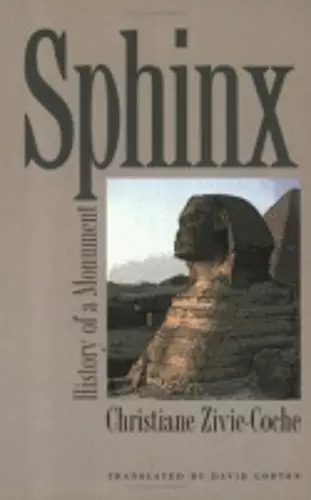Sphinx
History of a Monument
Christiane Zivie-Coche author David Lorton translator
Format:Hardback
Publisher:Cornell University Press
Published:11th Sep '02
Currently unavailable, and unfortunately no date known when it will be back
This hardback is available in another edition too:
- Paperback£23.99(9780801489549)

"Sphinxes are legion in Egypt—what is so special about this one?... We shall take a stroll around the monument itself, scrutinizing its special features and analyzing the changes it experienced throughout its history. The evidence linked to the statue will enable us to trace its evolution... down to the worship it received in the first centuries of our own era, when Egyptians, Greeks, and Romans mingled together in devotion to this colossus, illustrious witness to a past that was already more than two millennia old."—from the IntroductionThe Great Sphinx of Giza is one of the few monuments from ancient Egypt familiar to nearly everyone. In a land where the colossal is part of the landscape, it still stands out, the largest known statue in Egypt. Originally constructed as the image of King Chephren, builder of the second of the Great Pyramids, the Sphinx later acquired new fame in the guise of the sun god Harmakhis. Major construction efforts in the New Kingdom and Roman Period transformed the monument and its environs into an impressive place of pilgrimage, visited until the end of pagan antiquity.Christiane Zivie-Coche, a distinguished Egyptologist, surveys the long history of the Great Sphinx and discusses its original appearance, its functions and religious significance, its relation to the many other Egyptian sphinxes, and the various discoveries connected with it. From votive objects deposited by the faithful and inscriptions that testify to details of worship, she reconstructs the cult of Harmakhis (in Egyptian, Har-em-akhet, or "Horus-in-the-horizon"), which arose around the monument in the second millennium. "We are faced," she writes, "with a religious phenomenon that is entirely original, though not unique: a theological reinterpretation turned an existing statue into the image of the god who had been invented on its basis."The coming of Christianity ended the Great Sphinx's religious role. The ever-present sand buried it, thus sparing it the fate that overtook the nearby pyramids, which were stripped of their stone by medieval builders. The monument remained untouched, covered by its desert blanket, until the first excavations. Zivie-Coche details the archaeological activity aimed at clearing the Sphinx and, later, at preserving it from the corrosive effects of a rising water table.
Christiane Zivie-Coche's Sphinx: History of a Monument reflects her particular concern with the later history of the Giza sphinx and with the Giza plateau as a whole. This... translation... brings to an anglophone readership a wealth of detail about the appropriation of the sphinx in the New Kingdom and the Late Period, as a monument no longer exclusively tied to the old royal funerary cult but developing a religious status in its own right.
* Egyptian ArcheoloISBN: 9780801439629
Dimensions: 216mm x 140mm x 18mm
Weight: 454g
144 pages